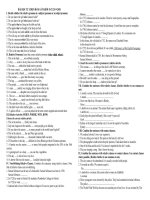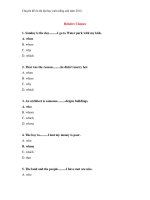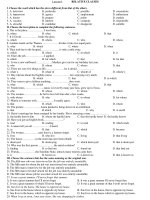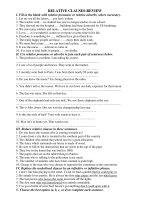EXTRA-EXERCISES ABOUT RELATIVE CLAUSES
Bạn đang xem bản rút gọn của tài liệu. Xem và tải ngay bản đầy đủ của tài liệu tại đây (112.34 KB, 7 trang )
<span class='text_page_counter'>(1)</span><div class='page_container' data-page=1>
ĐẠI TỪ QUAN HỆ- RELATIVE CLAUSE- ENGLISH 9
<b>I. Định nghĩa</b>
- Mệnh đề quan hệ là mệnh đề phụ được nối với mệnh đề chính bởi các đại từ quan hệ
(who, whom, whose, which, that ) hay các trạng từ quan hệ như (where, when, why). Mệnh
đề quan hệ đứng ngay đằng sau danh từ, đại từ trong mệnh đề chính để bổ sung ý nghĩa cho
danh từ, đại từ ấy,phân biệt danh từ đại từ ấy với các danh từ đại từ khác. Chức năng của nó
giống như một tính từ do vậy nó cịn được gọi là mệnh đề tính ngữ.
<b>II. CÁC ĐẠI TỪ QUAN HỆ</b>
<i><b>1. Who: -Là đại từ quan hệ chỉ người làm chủ ngữ, đứng sau tiền ngữ chỉ người để làm </b></i>
<i>chủ ngữ cho động từ đứng sau nó.-Theo sau who là một động từ</i>
Eg: The man who is sitting by the fire is my father. ->That is the boy who helped me to
find your house.
<i><b>2. Whom: -Là đại từ quan hệ chỉ người làm tân ngữ, đứng sau tiền ngữ chỉ người để làm </b></i>
tân ngữ cho động từ đứng sau nó.-Theo sau whom là một chủ ngữ
Eg: The woman whom you saw yesterday is my aunt.->The boy whom we are looking for
is Tom.
<i><b>3. Which:Là đại từ quan hệ chỉ vật, làm chủ ngữ hoặc tân ngữ cho động từ sau nó. </b></i>
-Theo sau which có thể là một động từ hoặc một chủ ngữ.
Eg: This is the book. I like it best.=> This is the book which I like best.
The hat is red. It is mine.=> The hat which is red is mine.
<i>-Khi which làm tân ngữ, ta có thể lược bỏ which</i>
<i>Eg: This is the book I like best . .The dress (which) I bought yesterday is very beautiful.</i>
<i><b> 4. That: Là đại từ quan hệ chỉ cả người lẫn vật, có thể được dùng thay cho Who, </b></i>
Whom, Which trong mệnh đề quan hệ thuộc loại Restricted Clause (Mệnh đề xác định)
Eg: That is the book that I like best.=>That is the bicycle that belongs to Tom.
My father is the person that I admire most.
I can see the girl and her dog that are running in the park.
<i><b> 5.Whose:Là đại từ quan hệ chỉ người, thay cho tính từ sở hữu. Whose cũng được dùng </b></i>
cho of which.
-Theo sau Whose luôn là 1 danh từ
Eg: The boy is Tom. You borrowed his bicycle yesterday.
=> The boy whose bicycle you borrowed yesterday is Tom.
John found a cat. Its leg was broken.
John found a cat whose leg was broken.
<b> III. CÁC TRẠNG TỪ QUAN HỆ</b>
<i><b>1. When: là trạng từ quan hệ chỉ thời gian, đứng sau tiền ngữ chỉ thời gian, dùng thay cho at,</b></i>
on, in + which, then
Eg: May Day is the day when people hold a meeting. (= on which)
I’ll never forget the day when I met her. (=on which)
That was the time when he managed the company. (= at which)
</div>
<span class='text_page_counter'>(2)</span><div class='page_container' data-page=2>
Eg: That is the house where we used to live. (= in which)
Do you know the country where I was born?
Hanoi is the place where I like to come.
<i><b>3. Why: là trạng từ quan hệ chỉ lí do, đứng sau tiền ngữ “the reason”, dùng thay cho “for the </b></i>
reason”
Eg: Please tell me the reason why you are so sad. (= for which)
He told me the reason why he had been absent from class the day before.
IV. CÁC LOẠI MỆNH ĐỀ QUAN HỆ: có ba loại mệnh đề quan hệ
1.Mệnh đề quan hệ xác định ( restrictive relative clause)
-Mệnh đề quan hệ xác định dùng để bổ nghĩa cho danh từ đứng trước, là bộ phận quan trọng
của câu,nếu bỏ đi mệnh đề chính khơng có nghĩa rõ ràng.
Eg The girl who is wearing the blue dress is my sister.
The book which I borrowed from you is very interesting.
2.Mệnh đề quan hệ không xác định (non- restrictive relative clause )
-Mệnh đề quan hệ không xác định dùng để bổ nghĩa cho danh từ đứng trước,là phần giải
thích thêm, nếu bỏ đi mệnh đề chính vẫn cịn nghĩa rõ ràng.
-Mệnh đề quan hệ khơng xác định thường được ngăn với mệnh đề chính bởi các dấu
phẩy. Danh từ đứng trước thường là tên riêng hoặc trước các danh từ thường có các từ
như: this, that, these, those, my, his her…đứng trước.
- Không được dùng that trong mệnh đề không xác định.
Eg My father, who is 50 years old, is a doctor.
This girl, whom you met yesterday, is my daughter.
3.Mệnh đề quan hệ nối tiếp.
- Mệnh đề quan hệ nối tiếp dùng để giải thích cả một câu, trường hợp này chỉ dùng đại từ
quan hệ which và dùng dấu phẩy để tách hai mệnh đề. Mệnh đề này luôn đứng ở cuối câu.
Eg He admires Mr Brown, which surprises me.
Mary tore Tom’s letter, which made him sad.
V.DẠNG RÚT GỌN CỦA MỆNH ĐỀ QUAN HỆ: mệnh đề quan hệ có thể rút gọn theo 4
cách:
1.Using participle phrases (sử dụng hiện tại phân từ)
- Present participle: Dùng cho các động từ trong mệnh đề quan hệ ở thể chủ động. Ta dùng
present participle phrase thay cho mệnh đề đó (bỏ đại từ quan hệ và trợ động từ, đưa động từ
chính về nguyên mẫu rồi thêm –ing)
The man who is sitting next to you is my uncle.
The man sitting to you is my uncle.
Do you know the boy who broke the windows last night?
Do you know the boy breaking the windows last night?
2.Using past participle:
- Past participle: Dùng cho các động từ trong mệnh đề quan hệ ở thể bị động (Bỏ đại từ quan
hệ, trợ động từ và bắt đầu cụm từ bằng past participle)
Eg1The books which were written by To Hoai are interesting.
The books written by To Hoai are interesting.
Eg2 The students who were punished by the teacher are lazy.
The students punished by the teacher are lazy.
</div>
<span class='text_page_counter'>(3)</span><div class='page_container' data-page=3>
The house built now belongs to Mr. Pike.
3.Using “to infinitive” or “infinitive phrase” (for sb to do): Bỏ đại từ quan hệ, bỏ chủ ngữ
và trợ động từ, bắt đầu cụm từ bằng “infinitive”
English is an important language which we have to master.
=> English is an important language to master.
There is a good restaurant where we can eat good food.
=> There is a good restaurant to eat good food.
That is the hotel where we can stay.
=> That is the hotel to stay.
Here is the form that you must fill in.
=> Here is the form for you to fill in.
4.Using noun phrases: mệnh đề quan hệ không xách định có thể được rút gọn bằng cách
dùng cụm danh từ.
Eg1 George Washington, who was the first presidentof the United States, was a general
in the army.
George Washington, the first presidentof the United States, was a general in the army.
Eg2 We visited Barcelona, which is a city in northern Spain.
We visited Barcelona, a city in northern Spain.
VI.GiớI Từ ĐI VớI MệNH Đề QUAN Hệ:
-Chỉ có hai đại từ quan hệ là Whom và which thường có giới từ đi kèm và giới từ có thể
đứng trước các đại từ quan hệ hoặc cuối mệnh đề quan hệ.
Eg1 The man about whom you are talkingis my brother.
The man (whom) you are talking about is my brother.
Eg2The picture at which you are looking is very expensive.
The picture ( which) you are looking at is very expensive.
Chú ý:
-Khi giới từ đứng cuối mệnh đề quan hệ thì ta có thể bỏ đại từ quan hệ và có thể dùng that
thay cho whom và which trong mệnh đề quan hệ xác định.
-Khi giới từ đứng trước đại từ quan hệ thì ta có khơng thể bỏ đại từ quan hệ và có khơng
thể dùng that thay cho whom và which .
VII.Lưu ý về mệnh đề quan hệ
1. Các đại từ quan hệ có chức năng tân ngữ trong mệnh đề quan hệ xác định đều có thể lược
bỏ.
Eg Do you know the boy (whom) we met yesterday?
That’s the house (which) I have bought.
-Tuy nhiên các đại từ quan hệ có chức năng tân ngữ trong mệnh đề quan hệ không xác định
không thể lược bỏ.
Eg Mr Tom, whom I spoke on the phone to , is very interested in our plan.
2. Khi danh từ được nói đến là tân ngữ của giới từ, ta có thể đưa giới từ đó đứng trước đại từ
quan hệ. Trường hợp này chỉ được dùng Whom và Which
<i>Miss Brown, with whom we studied last year, is a very nice teacher.</i>
</div>
<span class='text_page_counter'>(4)</span><div class='page_container' data-page=4>
3. Chú ý cách dùng của các cấu trúc mở đầu cho mệnh đề quan hệ: all, most, none, neither,
any, either, some, (a)few, both, half, each, one, two, several, many, much, + of which/whom
Daisy has three brothers, all of whom are teachers.
I tried on three pairs of shoes, none of which fitted me.
He asked me a lot of questions, most of which I couldn’t answer.
Two boys, neither of whom I had seen before, came into my class.
They have got two cars, one of which they seldom use.
There were a lot of people at the meeting, few of whom I had met before.
4. Các trường hợp sau đây thường phải dùng ‘that’
a. Khi cụm từ đứng trước vừa là danh từ chỉ người và vật
He told me about the places and people that he had seen in London
b. Sau các tính từ so sánh hơn nhất, first và last
This is the most interesting film that I’ve ever seen.
Moscow is the finest city that she’s ever visited.
That is the last letter that he wrote.
She was the first person that broke the silence.
c. Sau các từ all, only (duy nhất) và very (chính là)
All that he can say is this.
I bought the only book that they had.
You’re the very man that I would like to see.
d. Sau các đại từ bất định
He never says anything that is worth listening to.
I’ll tell you something that is very interesting.
WHO : dùng thế cho chủ từ - ngừoi
WHOM : dùng thế cho túc từ - ngừoi
WHICH : dùng thế cho chủ từ lẫn túc từ - vật
WHEN :dùng thế cho thời gian
WHERE :dùng thế cho nơi chốn
THAT :dùng thế cho tất cả các chữ trên ( có 2 ngoại lệ xem phần dưới )
WHOSE :dùng thế cho sở hửu ,người / vật
OF WHICH :dùng thế cho sở hửu vật
WHY :dùng thế cho lý do ( reason /cause )
Phân BiỆt GiỮa Whose Và Of Which
WHOSE : dùng cả cho người và vật
This is the book .Its cover is nice
-> This is the book whose cover is nice .
-> This is the book the cover of which is nice
WHOSE :đứng trứoc danh từ
OF WHICH : đứng sau danh từ ( danh từ đó phải thêm THE )
OF WHICH : chỉ dùng cho vật ,không dùng cho người.
This is the man . His son is my friend.
</div>
<span class='text_page_counter'>(5)</span><div class='page_container' data-page=5>
<b>I. Combine each pair of sentences using a relative pronoun or relative adverb</b>
1. She is the most intelligent woman. I’ve ever met this woman.
2. This doctor is famous. You visited him yesterday.
3. These children are orphans. She is taking care of these children.
4. The two young men are not good persons. You are acquainted with them.
5. My father goes swimming everyday. You met him this morning.
6. The man is my father. I respect this man most.
7. The man is my father. I respect his opinion most.
8. Mary and Margaret are twins. You met them yesterday.
9. I’ll introduce you to the man. His support is necessary for your project.
10. The middle-aged man is the director. My father is talking to him.
<b>II. Fill in the blanks with Relative pronouns or Relative adverbs where necessary</b>
1. Let me see all the letters _______ you have written.
2. Is there any one ________ can help me do this?
3. Mr. Brown, _________ is only 34, is the director of this company.
4. I know a place __________ roses grow in abundance.
5. It was the nurse ________ told me to come in.
6. The teacher with ________, we studied last year no longer teaches in our school.
7. They showed me the hospital ________ buildings had been destroyed by US bombings.
8. We saw many soldiers and tanks ______ were moving to the front.
9. Dr. Fleming, _______ discovered penicillin, was awarded the Nobel Prize for medicine in
1945.
10. He joined the political party _______ was in power.
<b>III. Use a Relative pronoun preceded by a preposition to combine each pair of</b>
<b>sentences below:</b>
1. This is a rare opportunity. You should take advantage of it to get a better job.
2. The boy is my cousin. You made fun of him.
3. This matter is of great importance. You should pay attention to it.
4. The woman lives next door to me. You gave place to her on the bus.
5. The examination lasted two days. I was successful in this examination.
6. This is the result of our work. I’m pleased with it.
7. There is a No parking sign. I do not take notice of it.
8. Mr. Brown is the man. I am responsible to him for my work.
9. Do you see my pen? I have just written the lesson with it.
10. We are crossing the meadow. We flew kites over it in our childhood.
<b>IV. Use Relative adverb to combine each pair of sentences below:</b>
1. This is the house. We often stay in this house in summer.
2. I’ll show you the second hand bookshop. You can find valuable books in this shop.
3. I have not decided the day. I’ll go to London on that day.
4. He was born on the day. His father was away on that day.
5. The book is a telephone directory. We can look up telephone numbers in this book.
6. Mrs. Brown rang Dr. Brown. He was going to carry out an urgent operation at that
moment.
7. The airport is the most modern one. We’re going to arrive at this airport.
</div>
<span class='text_page_counter'>(6)</span><div class='page_container' data-page=6>
9. The days were the saddest ones. I lived far from home on those days.
10. I never forget the park. We met each other for the first time at this park.
V. Choose the best answer
1) The book ____ I bought at the bookstore yesterday is expensive.
A. who B. whose C. that D. B & C are corre
2) What’s the name of the blonde girl ____ just came in?
A. whoB. whose C. whom D. A & B are correct
3) I don’t like people ____ lose their tempers easily.
A. who B. whose C. that D. A & C are correct
4) Mexico City, ____ has a population of over 10 million, is probably the fastest growing
city in the world.
A. which B. whose C. that D. A & B are corre
5) This is Henry, ____ sister works for my father.
A. who B. whose C. that D.All are correct
6) He’s the man ____ people like at first sight.
A. who B. whom C. that D. A & C are correct
7) Could you iron the trousers ____ are hanging up behind the door?
A. who B. which C. that D. B & C are correct
8) Where is the girl ____ sells tickets?
A. who B. whose C. whom D. A & C are correct
9) The man____ we consider our leader had much experience in climbing mountains.
A. who B. whose C. whom D. A & C are correct
10) The artist ____ name I couldn’t remember was one of the best I had ever seen.
A. who B. whose C. that D. A & C are correct
11) Frank invited Janet, ____ he had met in Japan, to the party.
A. who B. whose C. that D. A & C are correct
12 The girl ___ design had been chosen stepped to the platform to receive the
award.
A. whose B. whom C. that D. which
13) I need to find a painting ____ will match the rest of my room.
A. whose B. whom C. who D. which
14) There are too many poor people ____ do not have enough to eat in the world.
A. whose B. whom C. who D. which
15) The trees ____ have the beautiful flowers grow near the gate of the garden.
A. whose B. whom C. who D. which
16) The teacher ____ teaches us French is coming today.
A. whom B. who C. that D. B & C are correct
17) What’s the music to ____ you are listening?
A. whose B. which C. that D. B & C are correct
18) I don’t like the stories ____ have unhappy endings.
A. who B. which C. that D. B & C are correct
19) The students ____ don’t have library cards can’t borrow books from the library.
</div>
<span class='text_page_counter'>(7)</span><div class='page_container' data-page=7>
20) Betty is the most intelligent girl ____ I have ever met.
A. who B. whom C. that D. All are correct
</div>
<!--links-->









